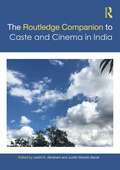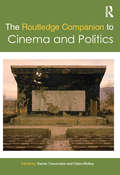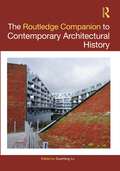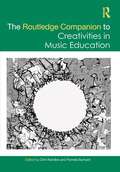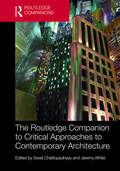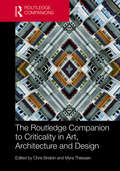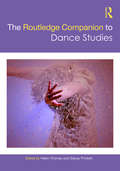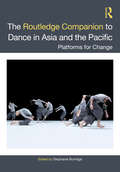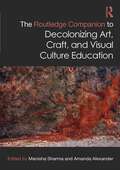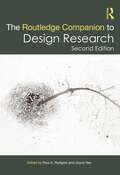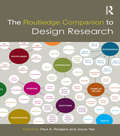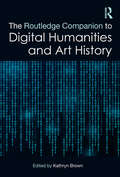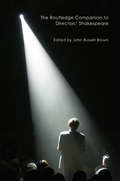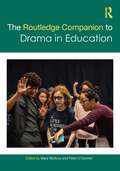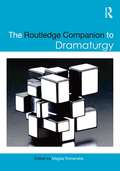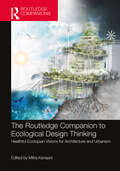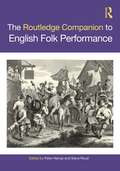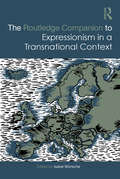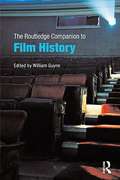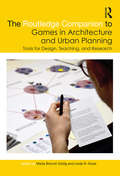- Table View
- List View
The Routledge Companion to Caste and Cinema in India
by Joshil K. Abraham Judith Misrahi-BarakThis companion is the first study of caste and its representation in Indian cinema. It unravels the multiple layers of caste that feature directly and indirectly in Indian movies, to examine not only the many ways caste pervades Indian society and culture but also how the struggle against it adopts multiple strategies. The companion: • critiques Indian cinema production through the lens of anti-caste discourse; • traces the history of films beginning from the early twentieth century, focusing on caste representations across India, including Hindi, Malayalam, Kannada, Marathi, Bengali, Punjabi, Tamil as well as silent films; • makes a foray into OTT media; • includes analysis of popular films such as Padmaavat, Masaan, Fandry, Sairat, Sujata, Article 15, Chomana Dudi, Lagaan, Court, Ee.Ma.Yau, Kaala, Pariyerum Perumal, Perariyathavar, among many others, to critique and problematise the idea of caste. A major intervention, this book alters traditional approaches to ‘caste’ in Indian cinemas and society and explores new political strategies implemented through cinematic creation and aesthetics. It will be indispensable for scholars and researchers of film studies, social discrimination and exclusion studies, human rights, popular culture, and South Asian studies. It will also be of interest to enthusiasts of Indian cinematic history.
The Routledge Companion to Caste and Cinema in India
by Joshil K. Abraham Judith Misrahi-BarakThis companion is the first study of caste and its representation in Indian cinema. It unravels the multiple layers of caste that feature directly and indirectly in Indian movies, to examine not only the many ways caste pervades Indian society and culture but also how the struggle against it adopts multiple strategies.The companion: Critiques Indian cinema production through the lens of anti-caste discourse Traces the history of films beginning from the early twentieth century, focusing on caste representations across India, including Hindi, Malayalam, Kannada, Marathi, Bengali, Punjabi, Tamil as well as silent films Makes a foray into OTT media Includes analysis of popular films such as Padmaavat, Masaan, Fandry, Sairat, Sujata, Article 15, Chomana Dudi, Lagaan, Court, Ee.Ma.Yau, Kaala, Pariyerum Perumal, Perariyathavar, among many others, to critique and problematise the idea of caste A major intervention, this book alters traditional approaches to ‘caste’ in Indian cinemas and society and explores new political strategies implemented through cinematic creation and aesthetics. It will be indispensable for scholars and researchers of film studies, social discrimination and exclusion studies, human rights, popular culture, and South Asian studies. It will also be of interest to enthusiasts of Indian cinematic history.
The Routledge Companion to Cinema and Politics (Routledge Media and Cultural Studies Companions)
by Yannis Tzioumakis Claire MolloyThe Routledge Companion to Cinema and Politics brings together forty essays by leading film scholars and filmmakers in order to discuss the complex relationship between cinema and politics. Organised into eight sections - Approaches to Film and Politics; Film, Activism and Opposition; Film, Propaganda, Ideology and the State; The Politics of Mobility; Political Hollywood; Alternative and Independent Film and Politics; The Politics of Cine-geographies and The Politics of Documentary - this collection covers a broad range of topics, including: third cinema, cinema after 9/11, eco-activism, human rights, independent Chinese documentary, film festivals, manifestoes, film policies, film as a response to the post-2008 financial crisis, Soviet propaganda, the impact of neoliberalism on cinema, and many others. It foregrounds the key debates, concepts, approaches and case studies that critique and explain the complex relationship between politics and cinema, discussing films from around the world and including examples from film history as well as contemporary cinema. It also explores the wider relationship between politics and entertainment, examines cinema’s response to political and social transformations and questions the extent to which filmmaking, itself, is a political act.
The Routledge Companion to Contemporary Architectural History
by Duanfang LuThe Routledge Companion to Contemporary Architectural History offers a comprehensive and up-to-date knowledge report on recent developments in architectural production and research. Divided into three parts – Practices, Interrogations, and Innovations – this book charts diversity, criticality, and creativity in architectural interventions to meet challenges and enact changes in different parts of the world through featured exemplars and fresh theoretical orientations. The collection features 29 chapters written by leading architectural scholars and highlights the reciprocity between the historical and the contemporary, research and practice, and disciplinary and professional knowledge. Providing an essential map for navigating the complex currents of contemporary architecture, the Companion will interest students, academics, and practitioners who wish to bolster their understanding of built environments.
The Routledge Companion to Contemporary Art, Visual Culture, and Climate Change (Routledge Art History and Visual Studies Companions)
by Subhankar Banerjee T. J. Demos Emily Eliza ScottInternational in scope, this volume brings together leading and emerging voices working at the intersection of contemporary art, visual culture, activism, and climate change, and addresses key questions, such as: why and how do art and visual culture, and their ethics and values, matter with regard to a world increasingly shaped by climate breakdown? Foregrounding a decolonial and climate-justice-based approach, this book joins efforts within the environmental humanities in seeking to widen considerations of climate change as it intersects with social, political, and cultural realms. It simultaneously expands the nascent branches of ecocritical art history and visual culture, and builds toward the advancement of a robust and critical interdisciplinarity appropriate to the complex entanglements of climate change. This book will be of special interest to scholars and practitioners of contemporary art and visual culture, environmental studies, cultural geography, and political ecology.
The Routledge Companion to Contemporary European Theatre and Performance
by Aneta Mancewicz Ralf RemshardtThis is a comprehensive overview of contemporary European theatre and performance as it enters the third decade of the twenty-first century. It combines critical discussions of key concepts, practitioners, and trends within theatre-making, both in particular countries and across borders, that are shaping European stage practice. With the geography, geopolitics, and cultural politics of Europe more unsettled than at any point in recent memory, this book’s combination of national and thematic coverage offers a balanced understanding of the continent’s theatre and performance cultures. Employing a range of methodologies and critical approaches across its three parts and ninety-four chapters, this book’s first part contains a comprehensive listing of European nations, the second part charts responses to thematic complexes that define current European performance, and the third section gathers a series of case studies that explore the contribution of some of Europe’s foremost theatre makers. Rather than rehearsing rote knowledge, this is a collection of carefully curated, interpretive accounts from an international roster of scholars and practitioners. The Routledge Companion to Contemporary European Theatre and Performance gives undergraduate and graduate students as well as researchers and practitioners an indispensable reference resource that can be used broadly across curricula.
The Routledge Companion to Creativities in Music Education (Routledge Music Companions)
by Clint Randles, Pamela BurnardViewing the plurality of creativity in music as being of paramount importance to the field of music education, The Routledge Companion to Creativities in Music Education provides a wide-ranging survey of practice and research perspectives. Bringing together philosophical and applied foundations, this volume draws together an array of international contributors, including leading and emerging scholars, to illuminate the multiple forms creativity can take in the music classroom, and how new insights from research can inform pedagogical approaches. In over 50 chapters, it addresses theory, practice, research, change initiatives, community, and broadening perspectives. A vital resource for music education researchers, practitioners, and students, this volume helps advance the discourse on creativities in music education.
The Routledge Companion to Critical Approaches to Contemporary Architecture
by Swati Chattopadhyay Jeremy WhiteThe Routledge Companion to Critical Approaches to Contemporary Architecture convenes a wide array of critical voices from architecture, art history, urbanism, geography, anthropology, media and performance studies, computer science, bio-engineering, environmental studies, and sociology that help us understand the meaning and significance of global architecture of the twenty-first century. New chapters by 36 contributors illustrated with over 140 black-and-white images are assembled in six parts concerning both real and virtual spaces: design, materiality, alterity, technologies, cityscapes, and practice.
The Routledge Companion to Criticality in Art, Architecture, and Design
by Chris Brisbin Myra ThiessenThe Routledge Companion to Criticality in Art, Architecture, and Design presents an in-depth exploration of criticism and criticality in theory and practice across the disciplines of art, architecture, and design. Professional criticism is a vital part of understanding the cultural significance of designed objects and environments that we engage with on a daily basis, yet there is evidence to show that this practice is changing. This edited volume investigates how practitioners, researchers, educators, and professionals engage with, think about, and value the practice of critique. With contributions from a multi-disciplinary authorship from nine countries - the UK, USA, Australia, India, Netherlands, Switzerland, South Africa, Belgium, and Denmark - this companion provides a wide range of leading perspectives evaluating the landscape of criticality and how it is being shaped by technological and social advances. Illustrated with over 60 black and white images and structured into five sections, The Routledge Companion to Criticality in Art, Architecture, and Design is a comprehensive volume for researchers, educators, and students exploring the changing role of criticism through interdisciplinary perspectives.
The Routledge Companion to Dance Studies (Routledge Companions)
by Helen Thomas Stacey PrickettThe Routledge Companion to Dance Studies maps out the key features of dance studies as the field stands today, while pointing to potential future developments. It locates these features both historically—within dance in particular social and cultural contexts—and in relation to other academic influences that have impinged on dance studies as a discipline. The editors use a thematically based approach that emphasizes that dance scholarship does not stand alone as a single entity, but is inevitably linked to other related fields, debates, and concerns. Authors from across continents have contributed chapters based on theoretical, methodological, ethnographic, and practice-based case studies, bringing together a wealth of expertise and insight to offer a study that is in-depth and wide-ranging. Ideal for scholars and upper-level students of dance and performance studies, The Routledge Companion to Dance Studies challenges the reader to expand their knowledge of this vibrant, exciting interdisciplinary field.
The Routledge Companion to Dance in Asia and the Pacific: Platforms for Change
by Stephanie BurridgeThis Companion documents and celebrates artistic journeys within the framework of rich and complex cultural heritages and traditional dance practices of the Asia-Pacific region. It presents various dance forms from Australia, Cambodia, China, Hong Kong, India, Indonesia, Malaysia, the Philippines, Singapore, Taiwan, Thailand, and the South Pacific. Drawing on extensive research and decades of performative experience as artists, choreographers, producers, teachers, and critics, the authors approach issues of dance and cultural diversity from a theoretical perspective while at the same time exploring change, process, and transformation through dance. The book discusses themes such as tradition, contemporization, interdisciplinarity, dance education, youth dance, dance networks, curatorial practices, and evolving performative practices of dance companies and independents. It also looks at regional networking, curating dance festivals and spaces that foster collaboration, regional cooperation, and cultural exchange, which are essential features of dance in Asia and the Pacific. This collection will be of interest to students and researchers of pedagogy, choreography, community dance practice, theatre and performance studies, social and cultural studies, aesthetics, interdisciplinary arts, and more. It will be an invaluable resource for artists and practitioners working in dance schools and communities.
The Routledge Companion to Decolonizing Art History (Routledge Art History and Visual Studies Companions)
by Charlene Villaseñor Black Tatiana Flores Florencia San MartínThis companion is the first global, comprehensive text to explicate, theorize, and propose decolonial methodologies for art historians, museum professionals, artists, and other visual culture scholars, teachers, and practitioners. Art history as a discipline and its corollary institutions—the museum, the art market—are not only products of colonial legacies but active agents in the consolidation of empire and the construction of the West. The Routledge Companion to Decolonizing Art History joins the growing critical discourse around the decolonial through an assessment of how art history may be rethought and mobilized in the service of justice—racial, gender, social, environmental, restorative, and more. This book draws attention to the work of artists, art historians, and scholars in related fields who have been engaging with disrupting master narratives and forging new directions, often within a hostile academy or an indifferent art world. The volume unpacks the assumptions projected onto objects of art and visual culture and the discourse that contains them. It equally addresses the manifold complexities around representation as visual and discursive praxis through a range of epistemologies and metaphors originated outside or against the logic of modernity. This companion is organized into four thematic sections: Being and Doing, Learning and Listening, Sensing and Seeing, and Living and Loving. The book will be of interest to scholars working in art history, visual culture, museum studies, race and ethnic studies, cultural studies, disability studies, and women’s, gender, and sexuality studies.
The Routledge Companion to Decolonizing Art History (Routledge Art History and Visual Studies Companions)
by Charlene Villaseñor Black Tatiana Flores Florencia San MartínThis companion is the first global, comprehensive text to explicate, theorize, and propose decolonial methodologies for art historians, museum professionals, artists, and other visual culture scholars, teachers, and practitioners.Art history as a discipline and its corollary institutions - the museum, the art market - are not only products of colonial legacies but active agents in the consolidation of empire and the construction of the West. The Routledge Companion to Decolonizing Art History joins the growing critical discourse around the decolonial through an assessment of how art history may be rethought and mobilized in the service of justice - racial, gender, social, environmental, restorative, and more. This book draws attention to the work of artists, art historians, and scholars in related fields who have been engaging with disrupting master narratives and forging new directions, often within a hostile academy or an indifferent art world. The volume unpacks the assumptions projected onto objects of art and visual culture and the discourse that contains them. It equally addresses the manifold complexities around representation as visual and discursive praxis through a range of epistemologies and metaphors originated outside or against the logic of modernity. This companion is organized into four thematic sections: Being and Doing, Learning and Listening, Sensing and Seeing, and Living and Loving.The book will be of interest to scholars working in art history, visual culture, museum studies, race and ethnic studies, cultural studies, disability studies, and women’s, gender, and sexuality studies.
The Routledge Companion to Decolonizing Art, Craft, and Visual Culture Education (Routledge Art History and Visual Studies Companions)
by Amanda Alexander Manisha SharmaThis companion demonstrates how art, craft, and visual culture education activate social imagination and action that is equity- and justice-driven. Specifically, this book provides arts-engaged, intersectional understandings of decolonization in the contemporary art world that cross disciplinary lines. Visual and traditional essays in this book combine current scholarship with pragmatic strategies and insights grounded in the reality of socio-cultural, political, and economic communities across the globe. Across three sections (creative shorts, enacted encounters, and ruminative research), a diverse group of authors address themes of histories, space and land, mind and body, and the digital realm. Chapters highlight and illustrate how artists, educators, and researchers grapple with decolonial methods, theories, and strategies—in research, artmaking, and pedagogical practice. Each chapter includes discursive questions and resources for further engagement with the topics at hand. The book is targeted towards scholars and practitioners of art education, studio art, and art history, K-12 art teachers, as well as artist educators and teaching artists in museums and communities.
The Routledge Companion to Design Research (Routledge Art History and Visual Studies Companions)
by Joyce Yee Paul A. RodgersThis new edition of The Routledge Companion to Design Research offers an updated, comprehensive examination of design research, celebrating a plurality of voices and range of conceptual, methodological, technological and theoretical approaches evident in contemporary design research. This volume comprises thirty-eight original and high-quality design research chapters from contributors around the world, with offerings from the vast array of disciplines in and around modern design praxis, including areas such as industrial and product design, visual communication, interaction design, fashion design, service design, engineering and architecture. The Companion is divided into four distinct sections with chapters that examine the nature and process of design research, the purpose of design research and how one might embark on design research. They also explore how leading design researchers conduct their design research through formulating and asking questions in novel ways, and the creative methods and tools they use to collect and analyse data. The Companion also includes a number of case studies that illustrate how one might best communicate and disseminate design research through contributions that offer techniques for writing and publicising research. The Routledge Companion to Design Research has a wide appeal to researchers and educators in design and design-related disciplines such as engineering, business, marketing, and computing, and will make an invaluable contribution to state-of-the-art design research at postgraduate, doctoral and post-doctoral levels and teaching across a wide range of different disciplines.
The Routledge Companion to Design Research (Routledge Art History and Visual Studies Companions)
by Paul A. Rodgers and Joyce YeeThe Routledge Companion to Design Research offers a comprehensive examination of design research, celebrating the plurality of design research and the wide range of conceptual, methodological, technological and theoretical approaches evident in contemporary design research. This volume comprises 39 original and high quality design research chapters from contributors around the world, with offerings from the vast array of disciplines in and around modern design praxis, including areas such as industrial and product design, visual communication, interaction design, fashion design, service design, engineering and architecture. The Companion is divided into five distinct sections with chapters that examine the nature and process of design research, the purpose of design research, and how one might embark on design research. They also explore how leading design researchers conduct their design research through formulating and asking questions in novel ways, and the creative methods and tools they use to collect and analyse data. The Companion also includes a number of case studies that illustrate how one might best communicate and disseminate design research through contributions that offer techniques for writing and publicising research. The Routledge Companion to Design Research will have wide appeal to researchers and educators in design and design-related disciplines such as engineering, business, marketing, computing, and will make an invaluable contribution to state-of-the-art design research at postgraduate, doctoral, and post-doctoral levels and teaching across a wide range of different disciplines.
The Routledge Companion to Digital Humanities and Art History (Routledge Art History and Visual Studies Companions)
by Kathryn BrownThe Routledge Companion to Digital Humanities and Art History offers a broad survey of cutting-edge intersections between digital technologies and the study of art history, museum practices, and cultural heritage. The volume focuses not only on new computational tools that have been developed for the study of artworks and their histories but also debates the disciplinary opportunities and challenges that have emerged in response to the use of digital resources and methodologies. Chapters cover a wide range of technical and conceptual themes that define the current state of the field and outline strategies for future development. This book offers a timely perspective on trans-disciplinary developments that are reshaping art historical research, conservation, and teaching. This book will be of interest to scholars in art history, historical theory, method and historiography, and research methods in education.
The Routledge Companion to Directors' Shakespeare (Routledge Companions)
by John Russell BrownThe Routledge Companion to Directors' Shakespeare is a major collaborative book about plays in performance. Thirty authoritative accounts describe in illuminating detail how some of theatre’s most talented directors have brought Shakespeare’s texts to the stage. Each chapter has a revealing story to tell as it explores a new and revitalising approach to the most familiar works in the English language. A must-have work of reference for students of both Shakespeare and theatre, this book presents some of the most acclaimed productions of the last hundred years in a variety of cultural and political contexts. Each entry describes a director’s own theatrical vision, and methods of rehearsal and production. These studies chart the extraordinary feats of interpretation and innovation that have given Shakespeare’s plays enduring life in the theatre. Notable entries include: Ingmar Bergman * Peter Brook * Declan Donnellan * Tyrone Guthrie * Peter Hall * Fritz Kortner * Robert Lepage * Joan Littlewood * Ninagawa Yukio * Joseph Papp * Roger Planchon * Max Reinhardt * Giorgio Strehler * Deborah Warner * Orson Welles * Franco Zeffirelli
The Routledge Companion to Drama in Education
by Mary McAvoyThe Routledge Companion to Drama in Education is a comprehensive reference guide to this unique performance discipline, focusing on its process-oriented theatrical techniques, engagement of a broad spectrum of learners, its historical roots as a field of inquiry and its transdisciplinary pedagogical practices. The book approaches drama in education (DE) from a wide range of perspectives, from leading scholars to teaching artists and school educators who specialise in DE teaching. It presents the central disciplinary conversations around key issues, including best practice in DE, aesthetics and artistry in teaching, the histories of DE, ideologies in drama and education, and concerns around access, inclusivity and justice. Including reflections, lesson plans, programme designs, case studies and provocations from scholars, educators and community arts workers, this is the most robust and comprehensive resource for those interested in DE’s past, present and future.
The Routledge Companion to Dramaturgy (Routledge Companions)
by Magda RomanskaDramaturgy, in its many forms, is a fundamental and indispensable element of contemporary theatre. In its earliest definition, the word itself means a comprehensive theory of "play making." Although it initially grew out of theatre, contemporary dramaturgy has made enormous advances in recent years, and it now permeates all kinds of narrative forms and structures: from opera to performance art; from dance and multimedia to filmmaking and robotics. In our global, mediated context of multinational group collaborations that dissolve traditional divisions of roles as well as unbend previously intransigent rules of time and space, the dramaturg is also the ultimate globalist: intercultural mediator, information and research manager, media content analyst, interdisciplinary negotiator, social media strategist. This collection focuses on contemporary dramaturgical practice, bringing together contributions not only from academics but also from prominent working dramaturgs. The inclusion of both means a strong level of engagement with current issues in dramaturgy, from the impact of social media to the ongoing centrality of interdisciplinary and intermedial processes. The contributions survey the field through eight main lenses: world dramaturgy and global perspective dramaturgy as function, verb and skill dramaturgical leadership and season planning production dramaturgy in translation adaptation and new play development interdisciplinary dramaturgy play analysis in postdramatic and new media dramaturgy social media and audience outreach. Magda Romanska is Visiting Associate Professor of Slavic Languages and Literatures at Harvard University, Associate Professor of Theatre and Dramaturgy at Emerson College, and Dramaturg for Boston Lyric Opera. Her books include The Post-Traumatic Theatre of Grotowski and Kantor (2012), Boguslaw Schaeffer: An Anthology (2012), and Comedy: An Anthology of Theory and Criticism (2014).
The Routledge Companion to Ecological Design Thinking: Healthful Ecotopian Visions for Architecture and Urbanism
by Mitra KanaaniThis companion investigates the ways in which designers, architects, and planners address ecology through the built environment by integrating ecological ideas and ecological thinking into discussions of urbanism, society, culture, and design. Exploring the innovation of materials, habitats, landscapes, and infrastructures, it furthers novel ecotopian ideas and ways of living, including human-made settings on water, in outer space, and in extreme environments and climatic conditions. Chapters of this extensive collection on ecotopian design are grouped under five different ecological perspectives: design manifestos and ecological theories, anthropocentric transformative design concepts, design connectivity, climatic design, and social design. Contributors provide plausible, sustainable design ideas that promote resiliency, health, and well-being for all living things, while taking our changing lifestyles into consideration. This volume encourages creative thinking in the face of ongoing environmental damage, with a view to making design decisions in the interest of the planet and its inhabitants. With contributions from over 79 expert practitioners, educators, scientists, researchers, and theoreticians, as well as planners, architects, and engineers from the U.S., Canada, Europe, and Asia, this book engages theory, history, technology, engineering, and science, as well as the human aspects of ecotopian design thinking and its implications for the outlook of the planet.
The Routledge Companion to English Folk Performance (Routledge Companions)
by Peter Harrop Steve RoudThis broad-based collection of essays is an introduction both to the concerns of contemporary folklore scholarship and to the variety of forms that folk performance has taken throughout English history. Combining case studies of specific folk practices with discussion of the various different lenses through which they have been viewed since becoming the subject of concerted study in Victorian times, this book builds on the latest work in an ever-growing body of contemporary folklore scholarship. Many of the contributing scholars are also practicing performers and bring experience and understanding of performance to their analyses and critiques. Chapters range across the spectrum of folk song, music, drama and dance, but maintain a focus on the key defining characteristics of folk performance – custom and tradition – in a full range of performances, from carol singing and sword dancing to playground rhymes and mummers' plays. As well as being an essential reference for folklorists and scholars of traditional performance and local history, this is a valuable resource for readers in all disciplines of dance, drama, song and music whose work coincides with English folk traditions.
The Routledge Companion to Expressionism in a Transnational Context (Routledge Art History and Visual Studies Companions)
by Isabel WünscheThe Routledge Companion to Expressionism in a Transnational Context is a challenging exploration of the transnational formation, dissemination, and transformation of expressionism outside of the German-speaking world, in regions such as Central and Eastern Europe, the Baltics and Scandinavia, Western and Southern Europe, North and Latin America, and South Africa, in the first half of the twentieth century. Comprising a series of essays by an international group of scholars in the fields of art history and literary and cultural studies, the volume addresses the intellectual discussions and artistic developments arising in the context of the expressionist movement in the various art centers and cultural regions. The authors also examine the implications of expressionism in artistic practice and its influence on modern and contemporary cultural production. Essential for an in-depth understanding and discussion of expressionism, this volume opens up new perspectives on developments in the visual arts of this period and challenges the traditional narratives that have predominantly focused on artistic styles and national movements.
The Routledge Companion to Film History
by William GuynnThe Routledge Companion to Film History is an indispensible guide for anyone studying film history for the first time. Incorporating a series of 11 introductory, critical essays on key subject areas, with a dictionary of key names and terms, it serves to introduce the reader to the field of film history in a comprehensive and well-rounded manner.
The Routledge Companion to Games in Architecture and Urban Planning: Tools for Design, Teaching, and Research
by Linda N. Groat Marta Brković DodigThe Routledge Companion to Games in Architecture and Urban Planning aims to identify and showcase the rich diversity of games, including: simulation games, game-like approaches, game scenarios, and gamification processes for teaching/learning, design and research in architecture and urban planning. This collection creates an opportunity for exchange and reflection on games in architecture and urban planning. Theoretical discussions, descriptive accounts, and case studies presenting empirical evidence are featured; combined with reflections, constructive critical analysis, discussions of connections, and various influences on this field. Twenty-eight international contributors have come together from eleven countries and five continents to present their studies on games in architecture and urban planning, pose new questions, and advocate for innovative perspectives.
